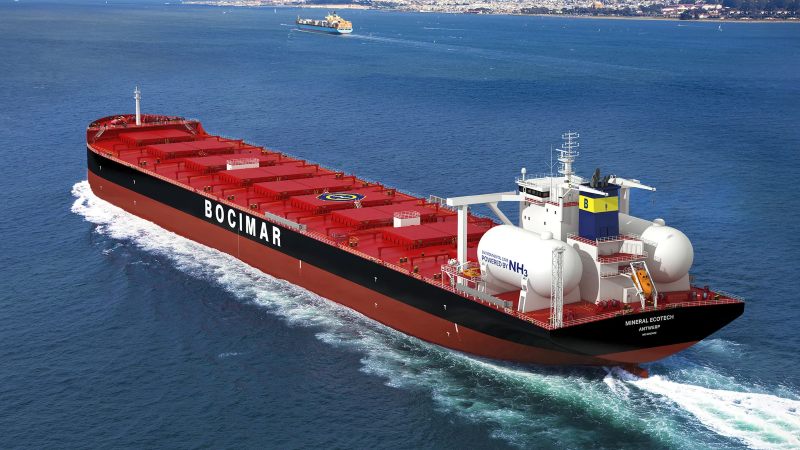Zero-carbon shipping
WinGD Dual-fuel Ammonia Engine
Mitsui O.S.K. Lines: bulk vessel bunkering in the Pilbara by 2030
MOL has become the first shipping line and future fuel customer to join the Pilbara Clean Fuels Bunkering Hub initiative. MOL aims for its under-development, Capesize bulk carrier vessels to be bunkered in the Pilbara by 2030, servicing the iron ore supply corridor between West Australia and East Asia.
Yang Ming & Hanwha Ocean: seven ammonia-ready container ships under construction
Adding to a pre-existing order of five LNG dual-fuel container vessels scheduled for delivery in 2026, Yang Ming has signed a shipbuilding contract with Hanwa Ocean for the construction of seven 16,000 TEU dual fuel ammonia-ready container ships to be delivered between 2028 and 2029.
Pherousa: trialing ammonia-propelled Ultramaxes for cross-Pacific copper ore transport
Pherousa Green Technologies has announced that its ammonia cracking-based maritime propulsion system will now enter a two-year pilot testing and deployment program. Pherousa will look to deploy its system on a series of 63,000 dwt Ultramax dry bulk carriers, with the first vessel to officially launch in 2030.
Panama Canal “NetZero” vessel slot to open this November
One spot per week will be allocated to a vessel registered as dual-fuel and capable of operating on at least one lower-emission fuel, such as ammonia. For the initial phases of the scheme, immediate use of the fuel will not be required, and the Canal Authority “recognize the investment and capacity to operate them once supply becomes available”.
Yara Clean Ammonia charters more dual-fuel vessels
Yara Clean Ammonia has reached a time-charter agreement with Navigator Ammon Shipping for two 51,000 m3 dual fuel midsized gas carriers to be delivered by October 2028. The company also celebrated the official start of construction of Yara Eyde, its new ammonia-powered container ship.
Hanwha Power Systems receives AiP for ammonia gas turbine retrofit
Hanwha Power Systems has received Approval in Principle from the American Bureau of Shipping for its ammonia gas turbine conversion design. Hanwha and partners are aiming for conversion of LNG carriers by 2028.
Everllence: first order for two-stroke ammonia engines
Everllence (formerly MAN Energy Solutions) will supply four 7S60ME-LGIA dual-fuel engines to Höegh Autoliners, for installation aboard Höegh’s new Aurora-class car carriers.
ITOCHU & Mitsui O.S.K. Lines: ammonia bunkering demonstrations planned for 2027
Mitsui O.S.K. Lines and ITOCHU will use their own vessels to demonstrate ship to ship ammonia bunkering in Singapore in 2027. This week, ITOCHU also signed collaboration agreements for the development of ammonia bunkering near the Suez Canal.









